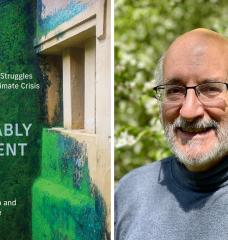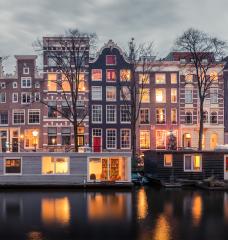
How can Hollywood help the climate?
Debbie Levin is the president and CEO of Environmental Media Association (EMA), a non-profit organization which utilizes the entertainment industry to spread environmentally-conscious messages. Since its inception in 1989, EMA has expanded beyond Hollywood with ongoing projects in education, business, and sustainability.
MIT Climate sat down with Debbie to discuss EMA’s goals and strategies, and how art fits into the bigger picture of social change. If you’re interested in Debbie’s work, check out the Environmental Media Association and their upcoming IMPACT Summit.
Mikaela: How did you get involved with EMA? What are your goals for the organization?
Debbie: I’ve been running the Environmental Media Association (EMA) since the beginning of 2000, which makes it 18 years. I came to EMA by divine intervention. Seriously, it was utterly “the road not taken” for me. I was invited to a small gathering for a luncheon that I learned was the 9th Annual Environmental Media Awards. I had no prior connection with environmental issues, other than recycling at home for my family and general awareness. Nor had I ever worked at a nonprofit.
As the mission unfolded, I felt “a lightning bolt” in my heart that resonated as I’ve never felt before. Everything said at the luncheon made all the sense in the world to me, but the scope of the organization was not on par with the potential. To me, this was the most important mission that I had ever heard. Literally life-changing for generations; for our planet. Having the freedom to create the “voice” for the environment within the entertainment industry is a gift that could never be underestimated.
Mikaela: How do you see EMA fitting into larger climate action/environmental justice goals?
Debbie: EMA is the only voice whose mission is to use our media (pop culture and otherwise) to motivate, share, explain and urge the global public to use their power to move towards a sustainable economy and lifestyle. The importance of our organization has never reached such a peak. We’re also penetrating the population that has been the toughest to convince.
By making our information digestible and relatable, we can reach the millions/billions of families that understand that the shift towards conscious, sustainable behaviors will ultimately be more economical and healthier for their families. Reaching the millions of families that don't always identify as "environmentalists" is quite an ambitious goal, but we feel that we are well on the road to accomplishing it.
Mikaela: What are some strategies EMA uses to spread environmental messages?
Debbie: Strategies have changed tremendously since we began our organization. Remember, that was before social media. We started out meeting with TV Showrunners (Producers/Writers) and actually pitched “green” storylines to add to their series. We offered research, connections within the environmental community as well as making sure their on set props were sending the right messages via recycling bins, canvas bags instead of paper or plastic ones. In 2003, when we created the EMA Green Seal for Production, that’s when we were able to clean up behind the scenes as well.
We would do campaigns with talent that would garner tremendous press. For example, banning plastic bags, doing PSAs about the importance of reading labels to avoid GMO's in products, etc. Of course, our events, like the Environmental Media Awards, got millions, now billions of media impressions all with an eye to educate and motivate the public. With the "take over" of social media, we have found our sweet spot. With over 250 million followers on our celebrity Board alone, we can push out "real time" messaging as often as we like. We do “EMA Social Sundays” -- where we send the Board Members the posts we believe should be shared! We also do many programs, campaigns, and three large-scale events that get hundreds of millions of views. Last year alone, we got 4 billion media hits. Our talent is our best voice to share inspiring and solution-based content.
Mikaela: What are some films that you feel utilize these strategies effectively?
Debbie: As early on as 2000, Erin Brockovich was a great example of showing a film filled with (then) new environmental issues and used the power of authentic storytelling to educate the global audience. Of course, now with HBO, Netflix, Amazon and all the streaming services including YouTube, access is huge and important films are being watched. Documentaries like Food, Inc. opened the eyes of millions of people; as has something as interesting as Netflix's Okja last year about animal cruelty and the tech industry.
Mikaela: How can art and media facilitate social or environmental change?
Debbie: Without media and corporate attention and social and consumer support, there can be no climate action and environmental justice. Our brilliant climate scientists, innovators, and social justice advocates all need a stage and an audience. They need to be heard, embraced and supported by the storytelling of their missions. Without that, all of their progress would remain a secret within their communities. Environmental solutions need the public’s demand for them to happen. Once that market is established, corporations can supply this demand on a global scale.
The “voice” that I mentioned that EMA represents can help be the storytellers of these ideas and ideals. Our diverse demographics that sit on our Board and activate our campaigns reach global populations in a way that scientists, entrepreneurs, universities, and corporations can’t reach, not at least with our level of emotional connection and authenticity. It’s our job to distribute messaging that resonates to the point of action within the public.

Social and environmental change literally cannot happen without artists and influencers in the public eye. Or to be more specific, using our ability to message through our platforms constantly. Honestly, we elected our President through the power of social media and the “story” the campaign was telling - good or bad. In other words, storytelling facilitates opinions and change. That's why it's so important that we tell the story of our planet and the people working to protect it. Our job at EMA is to be the highest and most efficient messengers of environmental issues, practices, solutions, and sustainable personal choices. As much as we can share, in the kindest and most relatable way, the more of an effect we have on the health of our planet and her inhabitants.
Mikaela: What advice would you give to filmmakers and artists who focus on environmental issues on getting their work/messages out there?
Debbie: My biggest advice is to pay attention to the story and entertainment value. Documentary, series or feature. If it's not compelling, people won't watch. You can put as much information, content and point of view as you want as long as it's interesting and something that your audience is engaged in watching.
Mikaela: If you had a magic wand and could change one thing regarding the politics or practices that contribute to climate change, what would you change?
Debbie: I'd need a whole bunch of magic wands for that! We need to support the young entrepreneurs that have solution-based companies and innovations and bring financial assistance and bring them into the corporate world so that we can change the culture to a sustainable economy. We can't wait for politics. We have these solutions now, and we need to support them.






